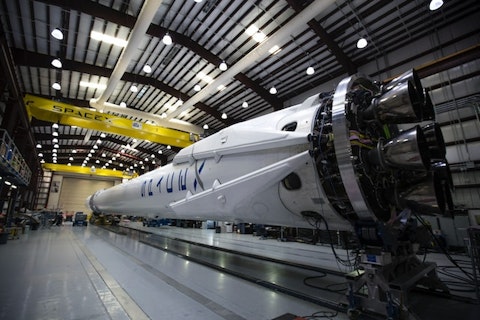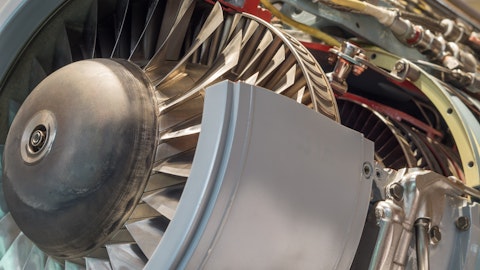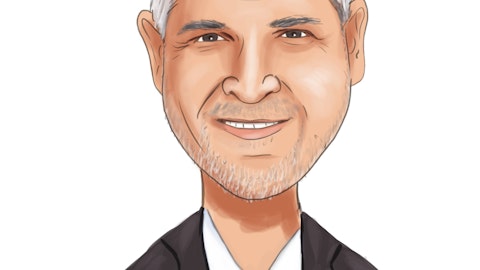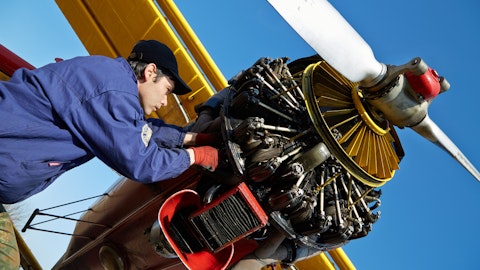Spirit AeroSystems Holdings, Inc. (NYSE:SPR) Q4 2022 Earnings Call Transcript February 7, 2023
Operator: Good morning, ladies and gentlemen and welcome to Spirit AeroSystems Holdings Inc.’s Fourth Quarter and Full Year 2022 Earnings Conference Call. My name is Glenn, and I will be your coordinator today. I would now like to turn the presentation over to Aaron Hunt, Director of Investor Relations. Please proceed.
Aaron Hunt: Thank you, Glenn, and good morning, everyone. Welcome to Spirit’s fourth quarter and full year 2022 results call. I am Aaron Hunt, Director of Investor Relations; and with me today are Spirit’s President and Chief Executive Officer, Tom Gentile; Senior Vice President and Chief Financial Officer, Mark Suchinski; Executive Vice President and President of Defense & Space Division, Duane Hawkins; and Spirit’s Executive Vice President and Chief Operating Officer and President of Commercial Division, Sam Marnick. After opening comments by Tom, Duane, and Mark regarding our performance and outlook, we will take your questions. Before we begin, I need to remind you that any projections or goals we may include in our discussion today are likely to involve risks, including those detailed in our earnings release, in our SEC filings, and the forward-looking statement at the end of this web presentation and referenced in our call today.
In addition, we refer you to our earnings release and presentation for disclosures and reconciliation of non-GAAP measures we use when discussing our results. And as a reminder, you can follow today’s broadcast and slide presentation on our website at spiritaero.com. With that, I’d like to turn the call over to our Chief Executive Officer, Tom Gentile.
Tom Gentile: Thank you, Aaron and good morning everyone. Welcome to Spirit’s fourth quarter and full year 2022 results call. Last year, we saw domestic travel continue to recover across the globe. The US was the best performing market, where air traffic was 2% below the 2019 level. And in China, we are encouraged to see some travel restrictions lifted in the 737 MAX return to service. Domestic air travel favors narrowbody aircraft like the A320 and the 737 MAX, both of which logged several significant new orders during the year. The orders and additional backlog provides support to Airbus and Boeing’s plans to increase narrowbody production rates further. We are encouraged by the continued demand, which we expect will benefit Spirit since 85% of our backlog is tied to narrowbody aircraft.
While demand remains robust, we experienced a number of challenges as we increased production rates during 2022. We had to hire a significant number of new employees who are taking time to reach the same level of proficiency as the workers we had prior to the pandemic. We also experienced higher levels of attrition with the new employees we hired. In addition, our suppliers encountered similar challenges, which resulted in higher levels of part shortages throughout the year. We also encountered higher levels of inflation. Despite these challenges, we managed to increase our production rates across several major programs by 27% overall. On the 737 program, we managed through the challenges as production increased from 162 units in 2021 to 281 units in 2022, a 73% increase.
To support the recovery and the expected higher level of production in 2023, we began hiring additional headcount in the fourth quarter, which drove additional cost, but is an investment to get ready for the production rate increases in 2023. While we expect to see ongoing supply chain challenges and issues, as we stabilize production, our December 737 production was 40 units, demonstrating our capability to produce at higher rates. In 2023, we plan to produce about 420 737 shipsets which includes the units behind schedule from 2022. In January, we delivered 33 737 units. Turning to our wide-body programs, the 787 program navigated through challenges last year, and we delivered 20 units to our customer. Our 787 production resumed with a new build process to address the fit and finish requirements applicable to all the partners on the program.
After completing a few units with the new process, we have found more labor per unit is needed than originally expected, which is one of the reasons driving an additional forward loss on future units this quarter. It is also taking us longer than we expected to rework the stored 787 units. We now believe we have incorporated what is needed for the 787 fit and finish requirements in the new-build process and rework. On our A350 program, we continue to see disruption, driving increased cost pressure. During the year, we saw continued disruptions from the supply chain. The transfer of parts and the ramp-up of production put the program behind schedule. We have initiated our recovery plan. However, recovery costs included expedited shipping of components to support our customers’ production are resulting in additional forward loss.
Mark will walk you through the details of the forward losses on these two programs in his section. We continue to support Airbus on their narrowbody programs. Our production was in line with demand from Airbus, and we expect to continue to produce to remain in sync with their production plans. In 2023, we plan to produce between 650 and 680 A320 units and about 80 A220 units. In looking at our wide-body programs for 2023, we will support our customers as they increase their production rates to support the international traffic recovery. On the 787 program, we expect to produce between 40 and 45 787 shipsets. On the A350 program, we plan to remain in sync with Boeing — or excuse me, with Airbus production as they increase from five to six aircraft per month and plan to produce about 60 units on the A350.
Now, let’s turn to our Defense and Aftermarket businesses. On Defense & Space, our segment President, Duane Hawkins is retiring from his current role in just a few weeks and will hand off the segment to Mark Miklos. Duane and the team have done a great job in building Spirits’ Defense & Space segment, and we wanted to give him an opportunity to take you through some of the many highlights from 2022. Duane?
Duane Hawkins: Thanks Tom. In 2022, the Defense & Space team did a really good job, executing on existing programs and winning some new ones. Across our five growth areas, hypersonics, UAS, next-generation effects, next-generation aircraft, and space, we expanded relationships with current customers and created some new ones. The Defense & Space segment revenues were up a little over 11% from 2022 to $650 million with approximately 11.2% margin. We had solid contributions from the P8 and KC-46 programs. On the CH-53K program, we began preparing for full rate production by developing our rate production tooling and manufacturing build plan, while also delivering LRIP units. And in December, we had the opportunity to attend the B-21 unveiling to celebrate the team’s contributions to this important new defense platform.
Spirit is one of the seven partners on the B-21 program. We have a strong pipeline of Defense & Space opportunities that we continue to pursue. In 2022, the team won multiple classified and unclassified programs that could eventually result in significant revenue for Spirit. One of the first in the year was a win for the B-52 commercial engine replacement program, where Spirit will build the struts and nacelles for approximately 78 aircraft that are in service. We were also selected to support the KC-135 horizontal stabilizer program, which will help extend the life of an aircraft we often see racing the skies here in Wichita. Another win in the year was the strategic partnership agreement for the Sierra Space Shooting Star Cargo module. In addition to the Shooting Stars, Sierra Space and Spirit will work together to advance a family of cargo modules and service modules.
And finally, we are closely monitoring the protest of the Army FLRAA award to our partner, Bell Helicopter and look forward to supporting them on this exciting new program. Spirit is proud to be a member of Team Valor. The Spirit National Defense Prototype Center, NDPC, continues to support development, prototyping, and industrialization capabilities to support our growth strategy. In addition to the NDPC, we have continued to repurpose some of our excess wide-body capacity to defense applications. So far, approximately 1.2 million square feet in Wichita has been transitioned to our Defense &Space business. This includes the establishment of our defense manufacturing center, which we’ll provide significant classified machining capability with full-size determinate assembly accuracy.
The ability of our team to be involved from the initial concept design to production is critical to optimizing how we can support customers on future programs. We closed out the year with the acquisition of , a small company in Rhode Island that has a great set of technologies that complements our capabilities. The 100,000 square foot facility and the 35 talented individuals brings some unique 3D composite weaving technology and equipment to enhance our portfolio that will support hypersonic weapon development as well as other new product development opportunities. I’m proud of the Defense & Space business that we’ve been building at Spirit. It’s on track to our target of $1 billion in Defense & Space revenue by 2025 with 12% to 14% segment margins.
And I look forward to working with our new Spirit Defense & Space leader, Mark Miklos as he takes over on April 1. Back to you, Tom.
Tom Gentile: Thanks Duane. Our Aftermarket business also had a strong year with revenue growth of 30% at 19% margins. The aftermarket team continued to build out our strategy to expand our MRO capabilities in key geographic regions. In Asia, we established multiple ways to support customers in that region. In April, we signed an agreement with GAMECO to be the Spirit authorized repair center in China. Then in September, we formed a joint venture with Evergreen Technologies Corporation in Taiwan and signed an MOU with Malaysia Airlines Berhad to establish repair services for nacelles and flight control surfaces. We also signed a partnership with Boeing to provide repair services for the MAX on flight control surfaces, nacelles, and thrust reversers.
We closed out the year with an MOU with Joramco, the engineering arm of Dubai Aerospace Enterprise to explore how to bring a range of composite and metallic aerostructure repairs and services to customers in the Mideast region. We continue to target $500 million of revenue for our Aftermarket business with margins in excess of 20% by2025. I’ll now turn it over to Mark to take you through more details on our results. Mark?
Mark Suchinski: Thank you, Tom and good morning everyone. We experienced significant pressure in 2022 due to production schedule volatility of constrained supply chain, ongoing inflation, and labor pressures, including shortages, high levels of attrition and increased training for our new hires. These challenges have resulted in higher than anticipated costs and disruptions in our factories. We expect some of these pressures to continue into 2023, particularly those related to the supply chain and training new employees. We enter 2023 strongly focused on execution and getting our factories and people in place to stabilize and support higher production rates. Now, let me take you through the details of our 2022 financial results.
Let’s start with revenue on slide two. Revenue for the year was $5 billion, up 27% from 2021. This improvement was primarily due to higher production on the 737, A320, and A220 programs, as well as increased Aftermarket and Defense & Space revenue, partially offset by lower production on the 747 and 787programs. The Defense & Space segment had a strong year with topline growth of 11%, increasing revenue by about $65 million. Aftermarket also displayed strong execution with revenue growth of 30% over 2021 levels. Turning to deliveries. Overall, narrowbody deliveries in 2022 were 37% higher than 2021. We delivered 119 more 737units and 124 more A320 units compared to 2021. Alternatively, wide-body program deliveries were down 6% compared to 2021, mainly driven by 17 less 787 units in 2022.
Overall, 2022 deliveries increased 27% year-over-year. Now, let’s turn to earnings per share on slide three. We reported earnings per share of negative $5.21 compared to negative $5.19 in 2021. Excluding certain items, adjusted EPS was negative $2.81 compared to negative $3.46 in the prior year. Operating margin was negative 6% compared to negative 12% in 2021. The improvement over 2021 is due to higher production rates, specifically on the 737 program, partially offset by continued disruption in our factories, resulting from part shortages and labor challenges, which led to out-of-sequence work and operational instability. Full year forward losses totaled $250 million and unfavorable cumulative catch-up adjustments were $28 million. This compared to $242 million of forward losses and $5 million of unfavorable cumulative catch-up adjustments in 2021.

Photo by Dev Benjamin on Unsplash
Specifically related to the fourth quarter of 2022, we incurred $114 million of forward losses, which were primarily driven by the 787 and A350 programs. The 787 forward loss of $38 million recorded in the fourth quarter was largely driven by higher cost estimates related to restarting the factory in ramping production as well as new build requirements on each unit resulting from the fit and finish issues. We forecast the cash impact from this loss to occur over the next four years. The A350 charge of $67 million in the fourth quarter of 2022 was a result of additional costs related to labor and part shortages, manufacturing quality issues, and additional freight to support our customer deliveries. In addition, during the fourth quarter, we experienced disruption resulting from transferring the production of parts from a supplier into our Kinston facility.
This resulted in additional disruptions to our factory and we have now initiated a recovery plan, which will result in additional costs. Approximately $40 million of that forward loss will have an impact to cash in 2023. Additionally, in the fourth quarter of 2022, we recognized unfavorable cumulative catch-up adjustments of $59 million, primarily driven by the 737 and A320 programs. On the 737 program, we experienced disruptions due to labor inefficiencies and continued part shortages, which exacerbated the behind schedule hours and our out-of-sequence work. To catch up and prepare for the next rate break, we’ve made the decision to accelerate the hiring and training of employees to support a rate of 42 aircraft per month. This investment has a near-term impact on the program’s profitability and cash flow, but we believe it is important to improve Spirit’s production efficiencies as well as prepare for higher production rates in the future.
The A320 program’s unfavorable adjustment was driven by operational and supply chain disruptions and increased costs related to material, freight, and labor. 2022 earnings also included $157 million of excess capacity costs, a decrease of $60 million over 2021. Other expense was $14 million compared to other income of $147 million in 2021. This variance was primarily due to pension plan termination activities that were undertaken separately in each of the years. 2021 included a curtailment gain of $61 million resulting from the closure of the defined benefit plans acquired as part of the Bombardier acquisition. And in 2022, we terminated the frozen US Pension Value Plan A, which resulted in non-cash charges of $108 million. We anticipate additional pretax noncash charge in the first quarter of 2023 for the final settlement accounting as well as tax-related charges for the income and excise taxes, which we expect to conclude no later than the second quarter.
Now, turning to free cash flow on slide four. Free cash flow usage for the year was $516 million, in line with the range we communicated on our third quarter call. Free cash flow in both years were impacted by several large one-time cash items, including a $300 million tax refund received in 2021, a payment of $154 million to the Belfast pension plan in 2021, as well as the repayment in 2022 of $123 million Boeing 737 advance that we received in 2019. In addition, 2022 free cash flow was negatively impacted by production schedule changes; the Ukraine, Russian conflict; headwinds from forward losses; labor constraints; supply chain part shortages, and inflationary pressures. There were also several other cash items in 2022 that will not recur going forward, including $38 million of a grant received from the AMJP program and $27 million of net pension-related benefits from the termination of the Pension Value Plan B.
Looking to 2023, we plan to deliver approximately 420 737 units and 650 to 680 A320s during the year, which will be the largest driver of cash flow improvement. Additionally, 2023 will be positively impacted by $120 million to $140 million of surplus cash from the termination of the Pension Value Plan A, partially offset by higher interest payments and a previously reserved litigation payment, which has been appealed. Incorporating all items, including the pension surplus cash, we are targeting 2023 free cash flow to be better than breakeven, reflected estimated capital expenditures in the range of $125 million to $150 million. We anticipate the first quarter free cash flow to be the weakest and cash flow improving throughout the last three quarters of the year, partially due to normal seasonality of our cash flows.
With that, let’s now turn to our cash and debt balances on slide five. We ended the year with $659 million of cash and $3.9 billion of debt. These balances reflect items I previously listed as drivers to free cash flow in addition to the $319 million payment to settle the repayable investment agreement in the first half of 2022 and the refinancing activity we completed during the fourth quarter of 2022, including refinancing and extending maturities on $800 million of existing debt and upsizing by $100 million. Now let’s discuss our segment performance, starting with the Commercial segment on slide six. In 2022, Commercial revenue was $4.1 billion, an increase of 30% compared to 2021, primarily due to higher production volumes on the 737, A220, and A320 programs, partially offset by lower production on the 747 and 787 programs.
Operating margin was negative 2% compared to negative 7% in 2021, driven by higher volumes on the 737. As I previously mentioned, the changes in estimates during the year included forward losses of $244 million and unfavorable cumulative catch-up adjustments of $30 million. In comparison, during 2021, the segment recorded $227 million of forward losses and $6 million of unfavorable cumulative catch-ups. The segment had excess cost of $150 million compared to $207 million in 2021. Additionally, the segment recognized $38million of charges related to the Russian sanctions, which had an impact during 2022. Now, let’s turn to the Defense & Space segment on slide seven. Defense & Space revenue grew to $650 million or 11% higher than 2021 due to higher development program activity and increased P-8 production.
Operating margin for the year increased to 11% compared to 8% in 2021. The improvement was due to higher classified program profit and the absence of non-recurring charges taken into 2021. In 2022, the segment recorded forward losses of $6 million and excess capacity cost of $8 million compared to forward losses of $14 million and excess capacity cost of $11 million in 2021. For our Aftermarket segment results, let’s turn to slide eight. Aftermarket revenues were $311 million, up 30%compared to 2021, primarily due to higher spare part sales as well as higher maintenance, repair, and overall activity. Operating margin for the year increased to 19% compared to 21% in 2021 due to one-time inventory adjustment charges as well as losses of $4.2 million related to the Russian sanction.
2022 was a more challenging year than we expected, production schedule volatility, a disrupted supply chain, labor constraints, and ongoing inflation resulted in increased costs, forward loss charges, and instability in our factories. Despite the many challenges during the year, there were several things that went right. Many of our financial metrics have reflected continued improvement over the last two years, and I expect the recovery to continue going forward. We have announced wins in our Defense & Space and aftermarket segments, and we have restructured our debt, including executing on refinancing activity, which has extended our maturities and settled a repayable investment agreement. As we enter 2023, we are working with our suppliers and our internal teams to stabilize production and position ourselves for higher production rates.
The focus on operational execution as well as optimizing our costs should enable us to improve profitability and cash flow as we move throughout2023. Now, let me turn it back over to Tom for some closing comments.
Tom Gentile: Thanks Mark. Demand remains strong in the global aerospace industry. However, it was a challenging year to navigate the supply chain and other challenges we faced. We worked hard to make progress to stabilize at higher production rates, and we were pleased to close the year with some positive results, which will provide strong foundation for 2023. As we enter 2023, we expect free cash flow to be positive as we benefit from increased narrowbody production rates and continue to work on improving our labor productivity and stabilizing our supply chain. We have seen some improvements from the depths of the pandemic but expect that there will still be some volatility as the recovery continues. After 4 challenging years since the first MAX crash in 2018, we see some positive trends in the market that will benefit Spirit.
Domestic traffic has recovered to 98% of what it was compared to 2019 levels, which will benefit narrowbody aircraft production. And 85% of Spirit’s backlog is narrowbody aircraft. Boeing has said that they do not want to develop a new aircraft until 2035, which is good news for Spirit since the MAX and all of our other Boeing programs will continue for many years to come. China has started to fly the MAX again. Both China Southern and Hainan have both made flights, which is very good news for that program and offers upside as China brings the stored MAX aircraft out of storage starts taking deliveries again and then eventually places new orders. Boeing just announced that they’re starting a fourth 737 MAX production line in Everett, which highlights their commitment to increasing rates on the MAX and that Spirit’s biggest and most profitable program.
And organic diversification in our Defense & Space segments and Aftermarket is progressing well. We also have some good growth opportunities in commercial including freighters for Airbus and Boeing eVTOL opportunities and other machining opportunities. For 2023, our three primary objectives will be what we are calling the three Rs. First, we must realize the production rate increases across all of our programs, while maintaining a safe workplace and improving quality. Second, we have to reduce structural costs to position Spirit to be profitable and cash flow positive even if production rates do not go up as fast as currently projected. We have assigned a senior executive and team of leaders to our cost optimization project focused in three areas; operations, infrastructure, and supply chain.
In the infrastructure area, our target is to reduce 1,000 indirect positions from our 2023 headcount plan through a combination of reductions, attrition, and closing open hiring requisitions. Third, we want to reenergize our workforce so that we are ready to meet the challenges ahead as fast as we can as we face the fastest growing rates in the history of the aviation industry. With that, we will be happy to take your questions.
See also 25 Most Famous Companies in the World and 25 Countries with the Most Billionaires.
Q&A Session
Follow Spirit Aerosystems Holdings Inc. (NYSE:SPR)
Follow Spirit Aerosystems Holdings Inc. (NYSE:SPR)
Operator: Thank you. Our first question comes from David Strauss from Barclays. David, your line is now open.
David Strauss: Great. Thanks. Good morning.
Tom Gentile: Good morning.
David Strauss: Free cash flow, so I guess prior to today, you were seeing better than breakeven without the pension cash gain, now you’re seeing kind of better than breakeven, but including that, I guess what changed in terms of your forecast? Because it looks like now 420 on the MAX would be better than what you were talking about before, which I think was 31 a month. So, if you can just help us reconcile what changed now versus your prior free cash flow guidance? Thanks.
Tom Gentile: Yes. So — thanks David. A lot of things have changed really since we made some of those forecasts. We have seen higher costs across the board in things like freight, utilities, and logistics, as well as labor. In addition, as we are looking at the — just the overall cost for production, those are going up. So, we mentioned that we’ve, for example, hired now up to 42 aircraft per month on the MAX program. That’s in advance of any rate increases to that level. And the reason we did that was to prepare ourselves for higher rates in the future. That means it’s a higher investment now. And so those are the types of pressures and headwinds that make us to conservatively estimate that we’ll be breakeven now, including the pension benefit of $120 million to $150 million. Mark, anything else to add?
Mark Suchinski: David, I think Tom summarized it right, we continue to see instability in our factories. We’re bringing in much higher headcount to support our 737 production, and that is going to have a negative impact on 2023 cost and cash flow. And so that is the first headwind and investment we need to make to drive stability in the factory and meet our delivery commitments to our customer. Secondly, I had mentioned some challenges in our Kinston facility, and we took an additional $60 plus million forward loss. And I had mentioned that that recovery is going to require us to hire more people, expedite shipments, and incur some additional costs to support our customer requirements and indicated that that cash impact will be $40 million, which was not incorporated in our last overall discussion.
And then I’ll also tell you, as we think about the supply chain that we have here, I think it’s going to put a little bit of pressure on our working capital. We’re needing to bring in additional inventory, provide some buffers ahead of the rate breaks, probably more so than we anticipated as the stability continues here. So, at this point in time, it’s early in the year. We’ve just started. We want to make sure that we’re providing you with some information that we can meet and we’ll continue to update you as we progress throughout the year.
David Strauss: Thank you.
Operator: Thank you, David. Our next question from Cai von Rumohr from Cowen. Cai, your line is now open.
Cai von Rumohr: Yes. Thanks so much. So, the pattern of cash flow throughout the year, maybe give us some color there. Is it all three quarters of red ink and then one quarter of black ink, if you just breakeven? And then related to that, you delivered 33 737s in January. Is that a sustainable rate? Or is that just — they were sort of pretty much done in the fourth quarter? And — because the inventory bulge and now they’re just getting out the door. So, that’s kind of tough to build so that we’re not going to get a huge benefit from delivering planes in the first quarter. Thank you.





